A Study on the Compatibility of a Food-Recording Application with Questionnaire-Based Methods in Healthy Japanese Individuals
Abstract
:1. Introduction
2. Materials and Methods
2.1. Participants
2.2. FFQg and BDHQ
2.3. Food-Recording Application (Asken)
2.4. Statistical Analysis
3. Results
3.1. Background of the Participants
3.2. The Diurnal Variations in Lipid and Storable Vitamin Consumption Were the Largest
3.3. Comparison of the Energy and Nutrient Intakes Measured Using the App, the FFQg, and the BDHQ
3.4. Relationships among the Energy and Major Nutrient Intakes Estimated Using the App (Asken), FFQg, and BDHQ
3.5. Verification of the Compatibility of the App (Asken) with the FFQg or BDHQ Using Bland-Altman Analysis
4. Discussion
5. Conclusions
Author Contributions
Funding
Institutional Review Board Statement
Informed Consent Statement
Data Availability Statement
Acknowledgments
Conflicts of Interest
References
- Ralph, J.L.; Von Ah, D.; Scheett, A.J.; Hoverson, B.S.; Anderson, C.M. Diet assessment methods: A guide for oncology nurses. Clin. J. Oncol. Nurs. 2011, 15, E114–E121. [Google Scholar] [CrossRef] [PubMed]
- El Sayed Ahmad, R.; Baroudi, M.; Shatila, H.; Nasreddine, L.; Chokor, F.A.Z.; Chehab, R.F.; Forman, M.R.; Naja, F. Validity and Reproducibility of a Culture-Specific Food Frequency Questionnaire in Lebanon. Nutrients 2020, 12, 3316. [Google Scholar] [CrossRef] [PubMed]
- Johnson, R.K. Dietary intake—How do we measure what people are genuinely eating? Obes. Res. 2002, 10 (Suppl. S1), 63S–68S. [Google Scholar] [CrossRef] [PubMed]
- Rupasinghe, W.S.; Perera, H.; Wickramaratne, N. A comprehensive review on dietary assessment methods in epidemiological research. J. Pub Health Nutri. 2020, 3, 204–211. [Google Scholar]
- Wakai, K. A review of food frequency questionnaires developed and validated in Japan. J. Epidemiol. 2009, 19, 1–11. [Google Scholar] [CrossRef] [PubMed]
- Kobayashi, S.; Honda, S.; Murakami, K.; Sasaki, S.; Okubo, H.; Hirota, N.; Notsu, A.; Fukui, M.; Date, C. Both comprehensive and brief self-administered diet history questionnaires satisfactorily rank nutrient intakes in Japanese adults. J. Epidemiol. 2012, 22, 151–159. [Google Scholar] [CrossRef] [PubMed]
- Kobayashi, S.; Murakami, K.; Sasaki, S.; Okubo, H.; Hirota, N.; Notsu, A.; Fukui, M.; Date, C. Comparison of relative validity of food group intakes estimated by comprehensive and brief-type self-administered diet history questionnaires against 16 d dietary records in Japanese adults. Public. Health Nutr. 2011, 14, 1200–1211. [Google Scholar] [CrossRef] [PubMed]
- Takahashi, K. Food Frequency Questionnaire Based on Food Groups for Estimating Individual Nutrient Intake. Jpn. J. Nutr. Diet. 2003, 61, 161–169. (In Japanese) [Google Scholar] [CrossRef]
- Iizuka, K.; Ishihara, T.; Watanabe, M.; Ito, A.; Sarai, M.; Miyahara, R.; Suzuki, A.; Saitoh, E.; Sasaki, H. Nutritional Assessment of Hospital Meals by Food-Recording Applications. Nutrients 2022, 14, 3754. [Google Scholar] [CrossRef] [PubMed]
- Ferrara, G.; Kim, J.; Lin, S.; Hua, J.; Seto, E. A Focused Review of Smartphone Diet-Tracking Apps: Usability, Functionality, Coherence with Behavior Change Theory, and Comparative Validity of Nutrient Intake and Energy Estimates. JMIR Mhealth Uhealth. 2019, 7, e9232. [Google Scholar] [CrossRef] [PubMed]
- Zhang, L.; Misir, A.; Boshuizen, H.; Ocké, M. A Systematic Review and Meta-Analysis of Validation Studies Performed on Dietary Record Apps. Adv. Nutr. 2021, 12, 2321–2332. [Google Scholar] [CrossRef] [PubMed]
- Kusuma, J.D.; Yang, H.L.; Yang, Y.L.; Chen, Z.F.; Shiao, S.P.K. Validating Accuracy of a Mobile Application against Food Frequency Questionnaire on Key Nutrients with Modern Diets for mHealth Era. Nutrients 2022, 14, 537. [Google Scholar] [CrossRef] [PubMed]
- Gill, S.; Panda, S. A Smartphone App Reveals Erratic Diurnal Eating Patterns in Humans that Can Be Modulated for Health Benefits. Cell Metab. 2015, 22, 789–798. [Google Scholar] [CrossRef] [PubMed]
- Shinozaki, N.; Murakami, K. Evaluation of the Ability of Diet-Tracking Mobile Applications to Estimate Energy and Nutrient Intake in Japan. Nutrients. 2020, 12, 3327. [Google Scholar] [CrossRef] [PubMed]
- Fukumoto, A.; Asakura, K.; Murakami, K.; Sasaki, S.; Okubo, H.; Hirota, N.; Notsu, A.; Todoriki, H.; Miura, A.; Fukui, M.; et al. Within-and between-individual variation in energy and nutrient intake in Japanese adults: Effect of age and sex difference on group size and number of records required for adequate dietary assessment. J. Epidemiol. 2013, 23, 178–186. [Google Scholar] [CrossRef] [PubMed]
- Al Amin, A.S.M.; Gupta, V. Vitamin B12 (Cobalamin). In StatPearls [Internet]; StatPearls Publishing: Treasure Island, FL, USA, 2023. Available online: https://pubmed.ncbi.nlm.nih.gov/32644558/ (accessed on 9 January 2023).
- Sizar, O.; Khare, S.; Goyal, A.; Givler, A. Vitamin D Deficiency. In StatPearls [Internet]; StatPearls Publishing: Treasure Island, FL, USA, 2023. Available online: https://pubmed.ncbi.nlm.nih.gov/30335299/ (accessed on 19 February 2023).
- McLean, R.M.; Farmer, V.L.; Nettleton, A.; Cameron, C.M.; Cook, N.R.; Campbell, N.R.C.; TRUE Consortium (International Consortium for Quality Research on Dietary Sodium/Salt). Assessment of dietary sodium intake using a food frequency questionnaire and 24-hour urinary sodium excretion: A systematic literature review. J Clin Hypertens 2017, 19, 1214–1230. [Google Scholar] [CrossRef] [PubMed]
- Schröder, H.; Covas, M.I.; Marrugat, J.; Vila, J.; Pena, A.; Alcántara, M.; Masiá, R. Use of a three-day estimated food record, a 72-hour recall and a food-frequency questionnaire for dietary assessment in a Mediterranean Spanish population. Clin. Nutr. 2001, 20, 429–437. [Google Scholar] [CrossRef] [PubMed]
- Burrows, T.L.; Martin, R.J.; Collins, C.E. A systematic review of the validity of dietary assessment methods in children when compared with the method of doubly labeled water. J. Am. Diet. Assoc. 2010, 110, 1501–1510. [Google Scholar] [CrossRef] [PubMed]
- Trabulsi, J.; Schoeller, D.A. Evaluation of dietary assessment instruments against doubly labeled water, a biomarker of habitual energy intake. Am. J. Physiol. Endocrinol. Metab. 2001, 281, E891–E899. [Google Scholar] [CrossRef] [PubMed]
- Martin, L.J.; Su, W.; Jones, P.J.; Lockwood, G.A.; Tritchler, D.L.; Boyd, N.F. Comparison of energy intakes determined by food records and doubly labeled water in women participating in a dietary-intervention trial. Am. J. Clin. Nutr. 1996, 63, 483–490. [Google Scholar] [CrossRef] [PubMed]
- Goris, A.H.; Westerterp-Plantenga, M.S.; Westerterp, K.R. Undereating and underrecording of habitual food intake in obese men: Selective underreporting of fat intake. Am. J. Clin. Nutr. 2000, 71, 130–134. [Google Scholar] [CrossRef] [PubMed]
- Heiman, T.; Olenik-Shemesh, D. Perceived Body Appearance and Eating Habits: The Voice of Young and Adult Students Attending Higher Education. Int. J. Environ. Res. Public. Health. 2019, 16, 451. [Google Scholar] [CrossRef] [PubMed]

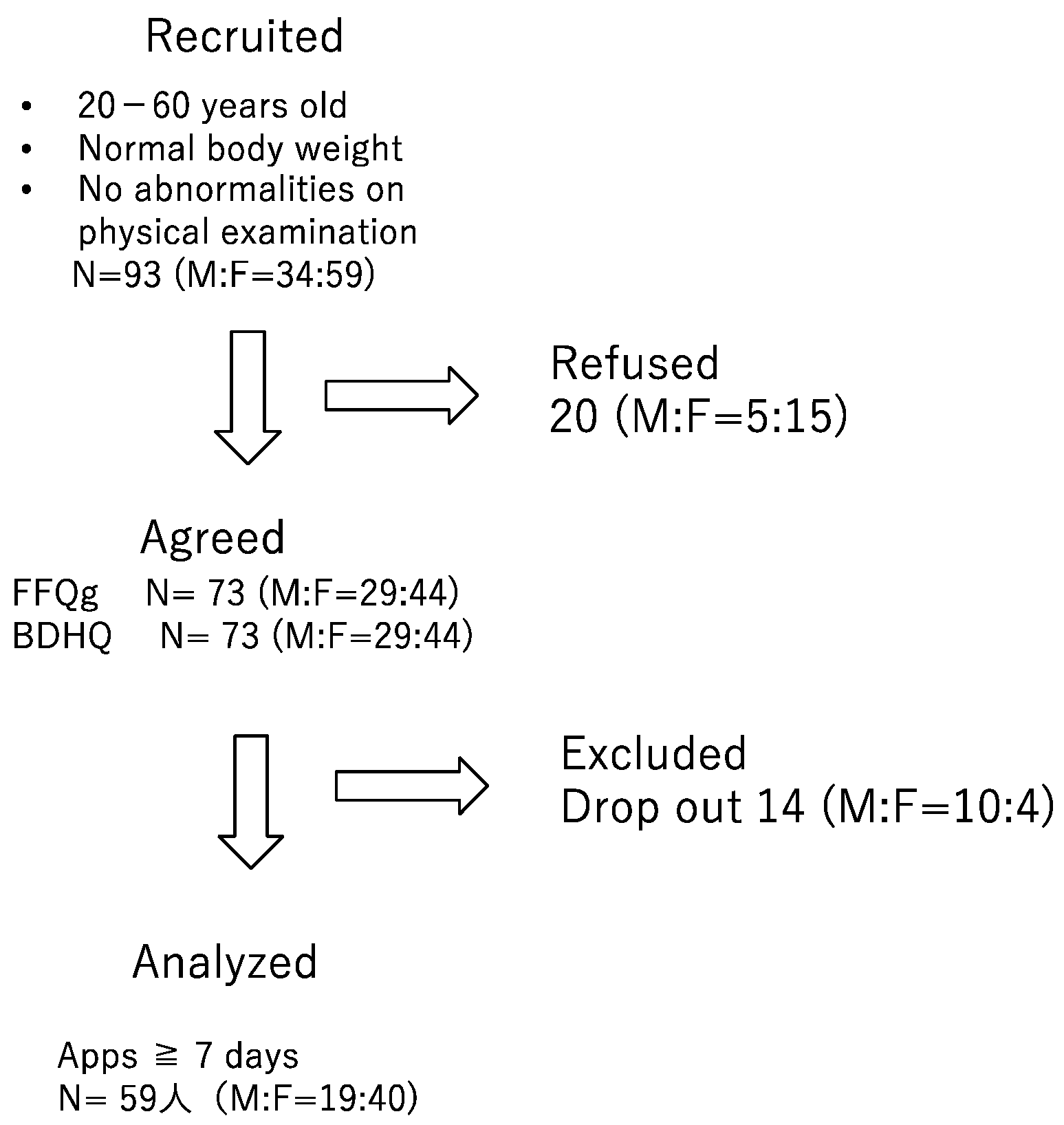
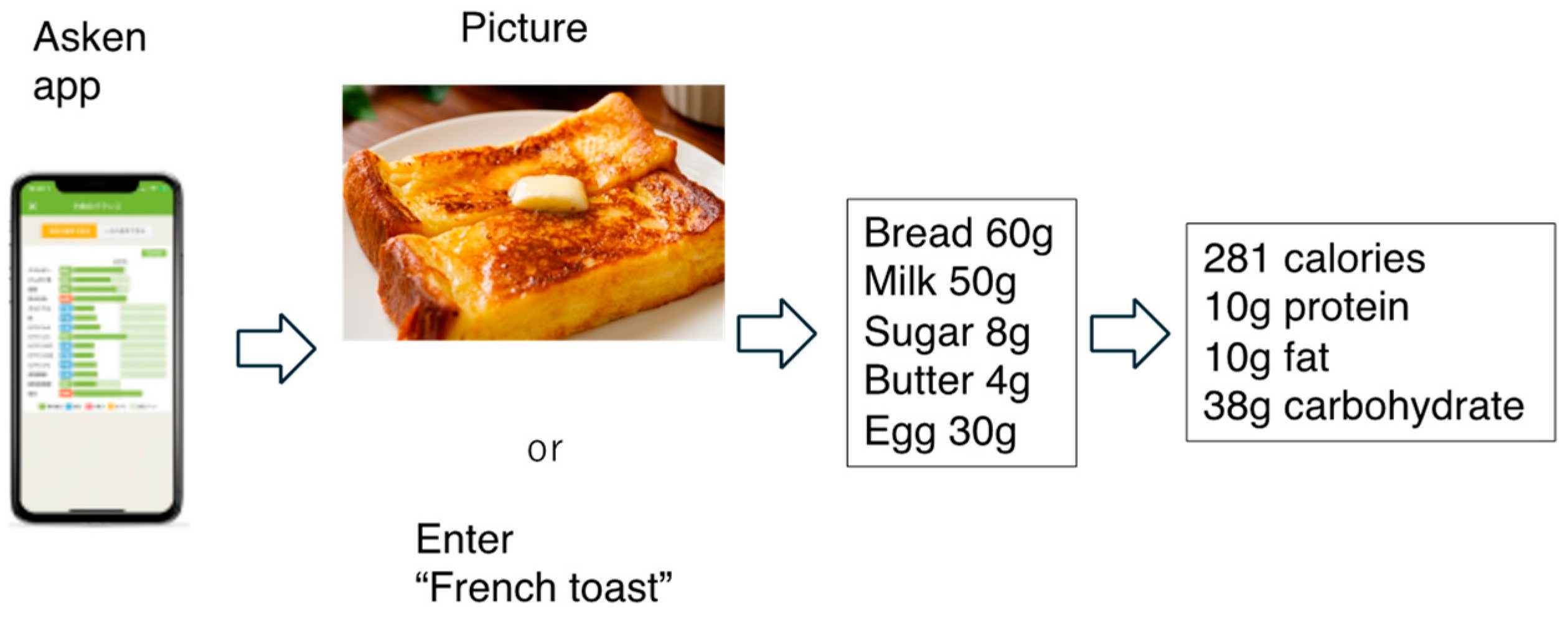
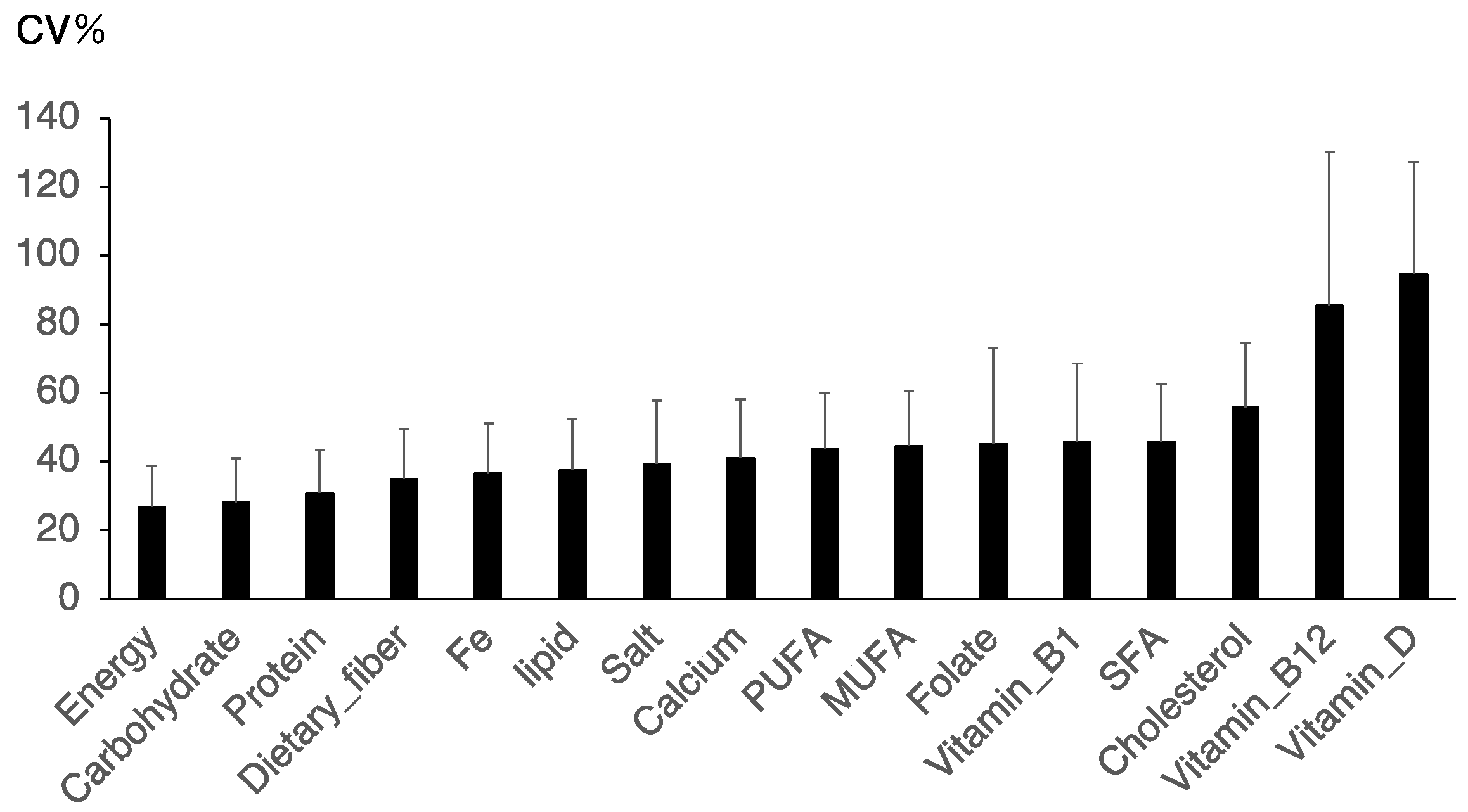
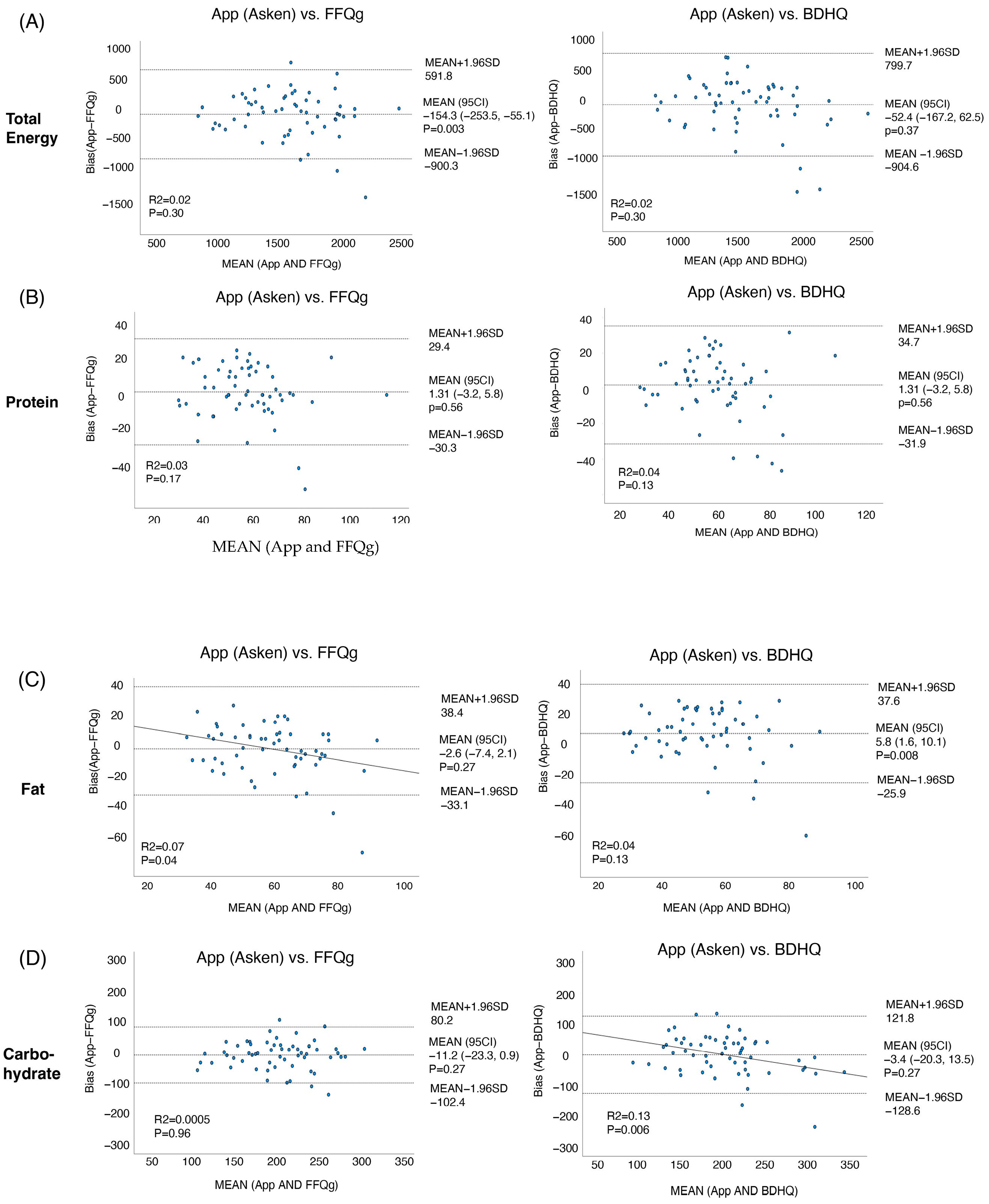
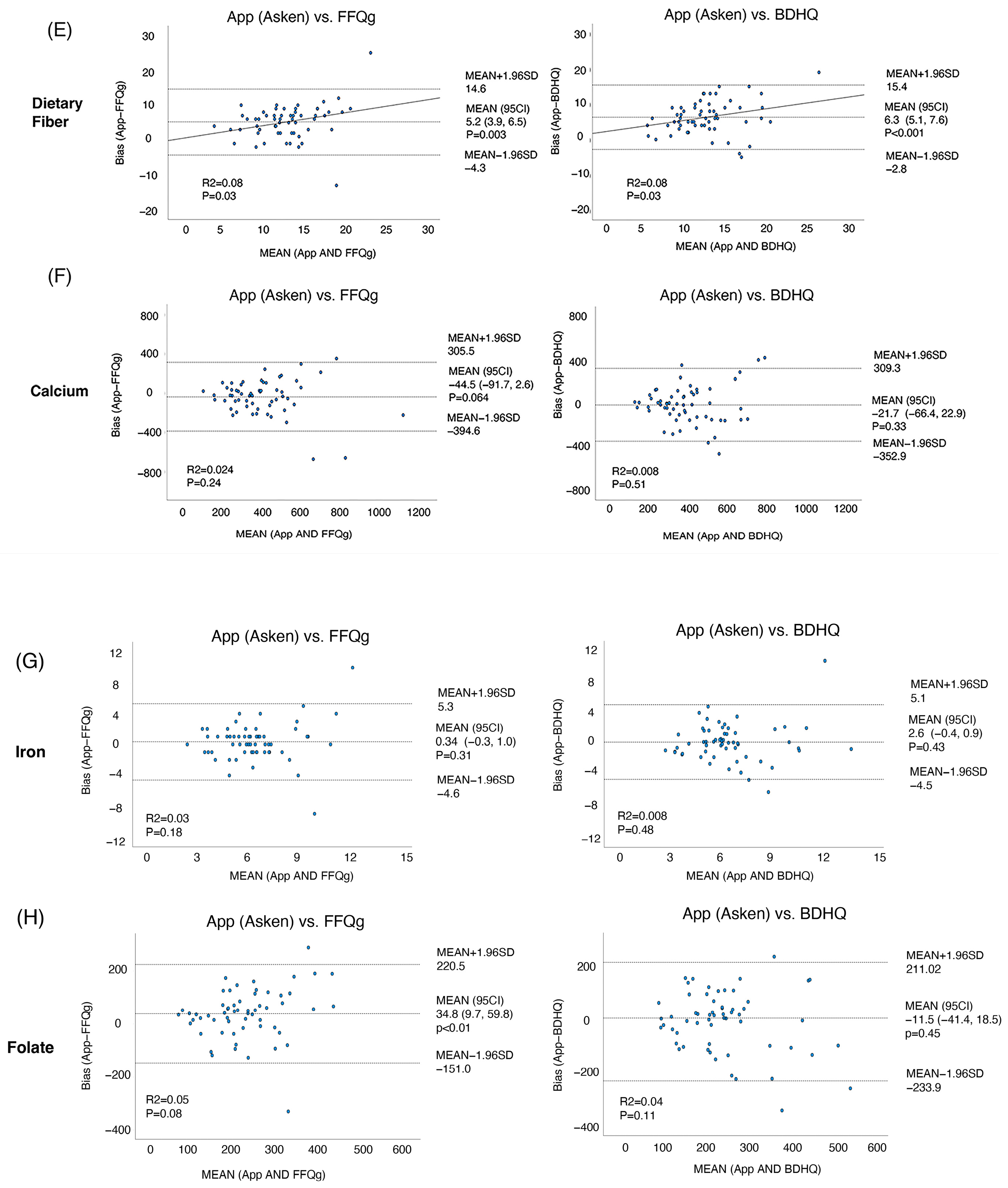
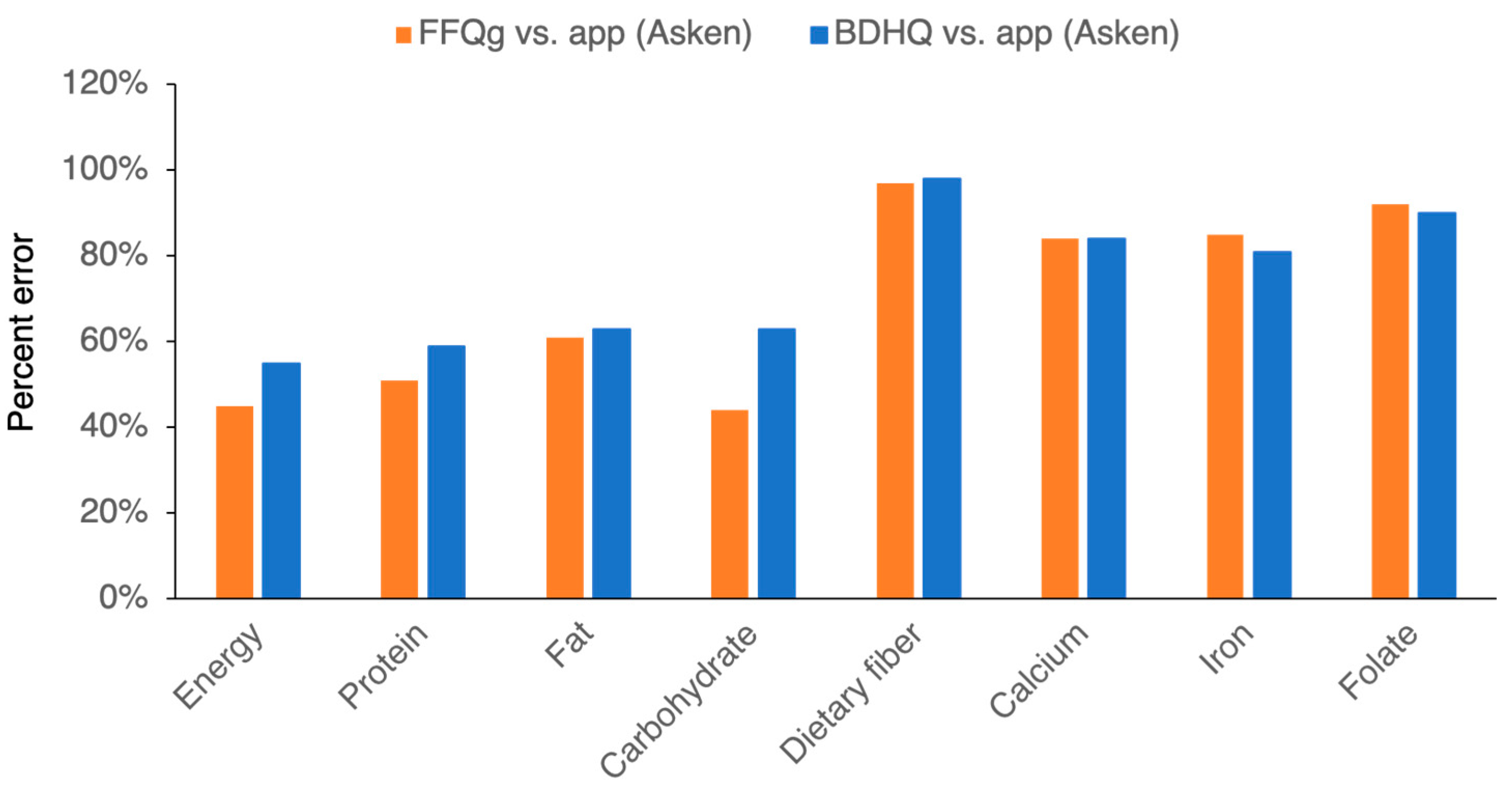
| Apps (Asken) | FFQg | BDHQ | |
|---|---|---|---|
| Character | Each meal record was entered into the app or photographed and analyzed by the app (duration was between a week and a month, 40% between 7–10 days). | Calculated according to how many times and how much of what food was eaten in a month | Calculated according to how many times and how much of what food was eaten in a month |
| Duration | From a week to a month | One time only | One time only |
| Time required for one time | 2–3 min per one time | 15 min | 20 min |
| Depend on Memeory | NO | YES | YES |
| Total (n = 59) | |
|---|---|
| M:F | 20:39 |
| Age (y.o.) | 35.6 ± 9.6 |
| Height (cm) | 163.7 ± 7.1 |
| BW (kg) | 55.7 ± 6.9 |
| BMI | 20.7 ± 1.5 |
| Numbers of Examinations (day) | 16.8 ± 9.5 |
| App (Asken) | FFQg | BDHQ | p Value | |
|---|---|---|---|---|
| Energy (kcal) | 1526.9 ± 381.3 | 1681.2 ± 427.6 ** | 1579.4 ± 493.9 | ** p < 0.01 vs. App |
| Protein (g) | 59.2 ± 15.8 | 59.5 ± 18.3 | 57.8 ± 18.9 | N.S. |
| Fat (g) | 57.1 ± 14.5 | 59.7 ± 18.7 | 51.2 ± 17.3 ** | ** p < 0.01 vs. App |
| Carbohydrate (g) | 198.6 ± 50.8 | 209.7 ± 50.5 | 202.0 ± 70.4 | NS |
| Dietary fiber (g) | 15.5 ± 5.1 | 10.3 ± 3.9 **** | 9.2 ± 4.0 **** | **** p < 0.0001 vs. App |
| Calcium (mg) | 383.6 ± 180.4 | 427.2 ± 205.4 | 404.4 ± 167.4 | N.S. |
| Iron (mg) | 6.4 ± 2.6 | 6.1 ± 2.2 | 6.2 ± 2.4 | N.S. |
| Salt (g) | 8.02 ± 2.02 | 7.6 ± 2.8 | 8.6 ± 2.6 | N.S. |
| Vitamin B1 (mg) | 0.93 ± 0.42 | 0.92 ± 0.30 | 0.66 ± 0.24 **** | **** p < 0.0001 vs. App |
| Folate (μg) | 242.2 ± 106.3 | 207.4 ± 86.8 | 253.6 ± 127.2 * | * p < 0.05 vs. App |
| Vitamin B12 (μg) | 4.40 ± 2.49 | 4.03 ± 2.04 | 6.15 ± 3.12 *** | *** p < 0.001 vs. App |
| Vitamin D (μg) | 4.89 ± 2.71 | 4.01 ± 2.27 | 8.46 ± 4.94 **** | **** p < 0.0001 vs. App |
| Cholesterol (mg) | 267.6 ± 89.0 | 294.6 ± 96.5 *** | 339.6 ± 130.7 *** | *** p < 0.001 vs. App |
| SFAs (g) | 16.5 ± 5.1 | 19.4 ± 6.4 ** | 14.1 ± 5.1 ** | ** p < 0.01 vs. App |
| MUFAs (g) | 21.0 ± 5.9 | 21.1 ± 6.4 | 18.8 ± 6.7 * | * p < 0.05 vs. App |
| PUFAs (g) | 10.3 ± 3.1 | 12.1 ± 4.3 ** | 12.0 ± 4.3 ** | ** p < 0.01 vs. App |
| FFQg vs. App (Asken) | BDHQ vs. App (Asken) | |||||||
|---|---|---|---|---|---|---|---|---|
| 95% CI | 95% CI | |||||||
| R | Lower | Upper | p Value | R | Lower | Upper | p Value | |
| Energy (kcal) | 0.57 | 0.37 | 0.72 | <0.01 | 0.53 | 0.31 | 0.69 | <0.001 |
| Protein (g) | 0.62 | 0.43 | 0.76 | <0.001 | 0.53 | 0.32 | 0.69 | <0.001 |
| Fat (g) | 0.43 | 0.19 | 0.62 | <0.001 | 0.49 | 0.27 | 0.66 | <0.001 |
| Carbohydrate (g) | 0.59 | 0.39 | 0.73 | <0.001 | 0.48 | 0.25 | 0.65 | <0.001 |
| Dietary fiber (g) | 0.45 | 0.22 | 0.63 | <0.001 | 0.5 | 0.28 | 0.67 | <0.001 |
| Calcium (mg) | 0.57 | 0.37 | 0.72 | <0.001 | 0.53 | 0.31 | 0.69 | <0.001 |
| Iron (mg) | 0.41 | 0.17 | 0.6 | 0.001 | 0.51 | 0.29 | 0.68 | <0.001 |
| Salt (g) | 0.15 | −0.12 | 0.39 | 0.27 | 0.37 | 0.13 | 0.58 | <0.01 |
| Vitamin B1 (mg) | 0.44 | 0.22 | 0.63 | <0.001 | 0.52 | 0.31 | 0.68 | <0.001 |
| Folate (μg) | 0.53 | 0.32 | 0.69 | <0.0001 | 0.53 | 0.32 | 0.7 | <0.0001 |
| Vitamin B12 (μg) | 0.46 | 0.23 | 0.64 | <0.001 | 0.4 | 0.16 | 0.59 | <0.01 |
| Vitamin D (μg) | 0.37 | 0.13 | 0.57 | <0.01 | 0.51 | 0.3 | 0.68 | <0.01 |
| Cholesterol (mg) | 0.4 | 0.16 | 0.59 | <0.01 | 0.39 | 0.14 | 0.59 | <0.01 |
| SFAs (g) | 0.49 | 0.27 | 0.66 | <0.0001 | 0.41 | 0.17 | 0.6 | <0.01 |
| MUFAs (g) | 0.38 | 0.13 | 0.58 | <0.01 | 0.47 | 0.24 | 0.64 | <0.001 |
| PUFAs (g) | 0.34 | 0.1 | 0.55 | <0.01 | 0.47 | 0.25 | 0.65 | <0.001 |
Disclaimer/Publisher’s Note: The statements, opinions and data contained in all publications are solely those of the individual author(s) and contributor(s) and not of MDPI and/or the editor(s). MDPI and/or the editor(s) disclaim responsibility for any injury to people or property resulting from any ideas, methods, instructions or products referred to in the content. |
© 2024 by the authors. Licensee MDPI, Basel, Switzerland. This article is an open access article distributed under the terms and conditions of the Creative Commons Attribution (CC BY) license (https://creativecommons.org/licenses/by/4.0/).
Share and Cite
Iizuka, K.; Deguchi, K.; Ushiroda, C.; Yanagi, K.; Seino, Y.; Suzuki, A.; Yabe, D.; Sasaki, H.; Sasaki, S.; Saitoh, E.; et al. A Study on the Compatibility of a Food-Recording Application with Questionnaire-Based Methods in Healthy Japanese Individuals. Nutrients 2024, 16, 1742. https://doi.org/10.3390/nu16111742
Iizuka K, Deguchi K, Ushiroda C, Yanagi K, Seino Y, Suzuki A, Yabe D, Sasaki H, Sasaki S, Saitoh E, et al. A Study on the Compatibility of a Food-Recording Application with Questionnaire-Based Methods in Healthy Japanese Individuals. Nutrients. 2024; 16(11):1742. https://doi.org/10.3390/nu16111742
Chicago/Turabian StyleIizuka, Katsumi, Kanako Deguchi, Chihiro Ushiroda, Kotone Yanagi, Yusuke Seino, Atsushi Suzuki, Daisuke Yabe, Hitomi Sasaki, Satoshi Sasaki, Eiichi Saitoh, and et al. 2024. "A Study on the Compatibility of a Food-Recording Application with Questionnaire-Based Methods in Healthy Japanese Individuals" Nutrients 16, no. 11: 1742. https://doi.org/10.3390/nu16111742
APA StyleIizuka, K., Deguchi, K., Ushiroda, C., Yanagi, K., Seino, Y., Suzuki, A., Yabe, D., Sasaki, H., Sasaki, S., Saitoh, E., & Naruse, H. (2024). A Study on the Compatibility of a Food-Recording Application with Questionnaire-Based Methods in Healthy Japanese Individuals. Nutrients, 16(11), 1742. https://doi.org/10.3390/nu16111742








